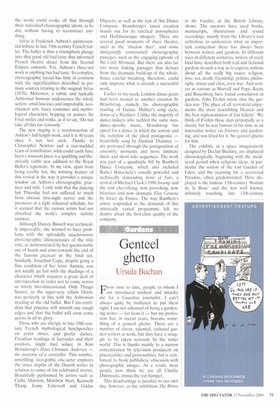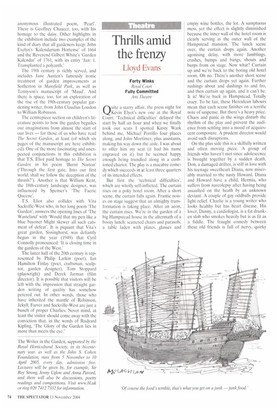Genteel ghetto
Ursula Buchan
Uroin time to time, people to whom I am introduced mishear and mistake me for a Guardian journalist. I can't always quite be bothered to put them right. I am not ashamed of being a gardening writer — far from it — but my profession has, in recent years, become something of a genteel ghetto. There are a number of clever, talented, cultured garden writers at work, but they have a struggle to be taken seriously by the wider world. This is thanks mainly to a narrow concentration by television producers on practicalities and personalities, but is reinforced by book publishers' obsession with photographic images. As a result, most people now think we are all Charlie Dimmocks, minus the top hamper.
This disadvantage is peculiar to our own day, however, as the exhibition The Writer in the Garden, at the British Library, shows. The curators have used books, manuscripts, illustrations and sound recordings, mainly from the Library's vast collection, to underscore what an important connection there has always been between writers and gardens. In different ways in different centuries, writers of every kind have described both real and fictional gardens in such a way as to express notions about all the really big issues: religion, love, sex, death, friendship, politics, philosophy, status and class, even war. And writers as various as Marvell and Pope, Keats and Rosenberg have found consolation in gardens. John Evelyn wrote that the garden was 'The place of all terrestrial enjoyments the most resembling Heaven and the best representation of lost felicity'. We think of Evelyn these days principally as a diarist, but he was famous in his time as an innovative writer on forestry and gardening, and was feted for it. No genteel ghetto for him.
The exhibits, in a space imaginatively designed by Declan Buckley, are displayed chronologically, beginning with the mediaeval period when religious ideas, in particular the notion of the lost Garden of Eden, and the yearning for a recovered Paradise, often predominated. Here displayed is the famous 13th-century 'Roman de la Rose' and the less well known, infinitely touching, late 14th-century anonymous illustrated poem, 'Pearl'. There is Geoffrey Chaucer, too, with his homage to the daisy. Other highlights in the exhibition include two examples of the kind of diary that all gardeners keep: John Evelyn's `Kalendarium Hortense' of 1664 and the Reverend Gilbert White's 'Garden Kalendar' of 1761, with its entry 'Jan: 1. Transplanted a polyanth.'
The 19th century is richly served, and includes Jane Austen's famously ironic treatment of garden improvements at Sotherton in Mansfield Park, as well as Tennyson's manuscript of 'Maud'. And there is space, too, for an exploration of the rise of the 19th-century popular gardening writer, from John Claudius Loudon to William Robinson.
The centrepiece section on children's literature points to how the garden beguiles our imaginations from almost the start of our lives — for those of us who have read The Secret Garden, at least (of which six pages of the manuscript are here exhibited). One of the more fascinating and unexpected conjunctions in this exhibition is that T.S. Eliot paid homage to The Secret Garden in his poem 'Burnt Norton' (`Through the first gate, Into our first world, shall we follow the deception of the thrush?'). Another is that William Kent, the 18th-century landscape designer, was influenced by Spenser's 'The Faerie Queene'.
T.S. Eliot also collides with Vita Sackville-Wcst who, in her long poem 'The Garden', answers the opening lines of 'The Wasteland' with 'Would that my pen like a blue bayonet Might skewer all such catsmeat of defeat'. It is piquant that Vita's great garden, Sissinghurst, was defiantly begun in the year (1949) that Cyril Connolly pronounced: 'It is closing time in the gardens of the West.'
The latter half of the 20th century is represented by Philip Larkin (poet), Ian Hamilton Finlay (poet, craftsman, sculptor, garden designer), Tom Stoppard (playwright) and Derek Jarman (film director). It is possible that visitors will be left with the impression that straight garden writing of quality has somehow petered out. In other words, those who have inherited the mantle of Robinson, Jekyll, Farrer and Sackville-West are just a bunch of proper Charlies. Never mind, at least the visitor should come away with the conviction that, in the words of Rudyard Kipling, The Glory of the Garden lies in more than meets the eye.'
The Writer in the Garden, supported by the Royal Horticultural Society, in its bicentenary year, as well as the John S. Cohen Foundation, runs from 5 November to 10 April 2005, every day, admission free. Lectures will be given by, for example, Sir Roy Strong, Jenny Uglow and Anna Pavord, and there will also be discussions, poetry readings and competitions. Visit www.bl.uk or ring 020 7412 7332 for information.



























































































 Previous page
Previous page